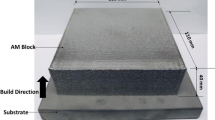Abstract
FIBRE or filament reinforcement of metals is usually carried out by the conventional processes of hot rolling, vacuum infiltration or diffusion bonding of the reinforcement with the matrix metal1. There is a danger that the high temperature attained in such processes, if maintained for a long time, will cause a reaction between matrix and reinforcement with the production of inter-metallic compounds and possible weakening of the composite. There is also the problem of preventing the formation of oxide films when the use of fluxes or inert atmospheres are undesirable or inconvenient. We suggest that high pressure bonding by means of an explosive would avoid these types of reaction, because the shock temperature rise is of short duration and the residual temperature is only of the order of tens of degrees.
This is a preview of subscription content, access via your institution
Access options
Subscribe to this journal
Receive 51 print issues and online access
$199.00 per year
only $3.90 per issue
Buy this article
- Purchase on Springer Link
- Instant access to full article PDF
Prices may be subject to local taxes which are calculated during checkout
Similar content being viewed by others
References
Standifer, L. R., Z. Metallkunde, 58, 512 (1967).
Cowan, G. R., and Holtzmann, A. H., Welding Res. Counc. Bull., No. 104, 1 (1965).
Wright, E. S., and Bayce, A. E., NATO Conf. on High Energy Rate Working of Metals, Sandefjord Lillehammer, 1, 448 (September 1964).
Author information
Authors and Affiliations
Rights and permissions
About this article
Cite this article
JARVIS, C., SLATE, P. Explosive Fabrication of Composite Materials. Nature 220, 782–783 (1968). https://doi.org/10.1038/220782a0
Received:
Issue Date:
DOI: https://doi.org/10.1038/220782a0
This article is cited by
-
Ab Initio Study of the Influence of Alloying Elements on Stability and Mechanical Properties of Selected TixAly Intermetallic Compounds and Their TixAly/Al, TixAly/Ti Interfaces in Explosively Welded Metal–Metal Composites
Metallurgical and Materials Transactions A (2021)
-
Interaction of constituents of fibrous composite material under conditions of orthogonal propagation of the sandwiching front during explosive welding
Combustion, Explosion, and Shock Waves (1981)
-
Buckling of reinforced fibers during explosive welding
Experimental Mechanics (1981)
-
Conditions for the formation of a joint of a fibrous composite material by explosion welding
Combustion, Explosion, and Shock Waves (1979)
-
Structure and properties of a titanium-molybdenum composite obtained by explosive welding
Combustion, Explosion, and Shock Waves (1977)
Comments
By submitting a comment you agree to abide by our Terms and Community Guidelines. If you find something abusive or that does not comply with our terms or guidelines please flag it as inappropriate.



